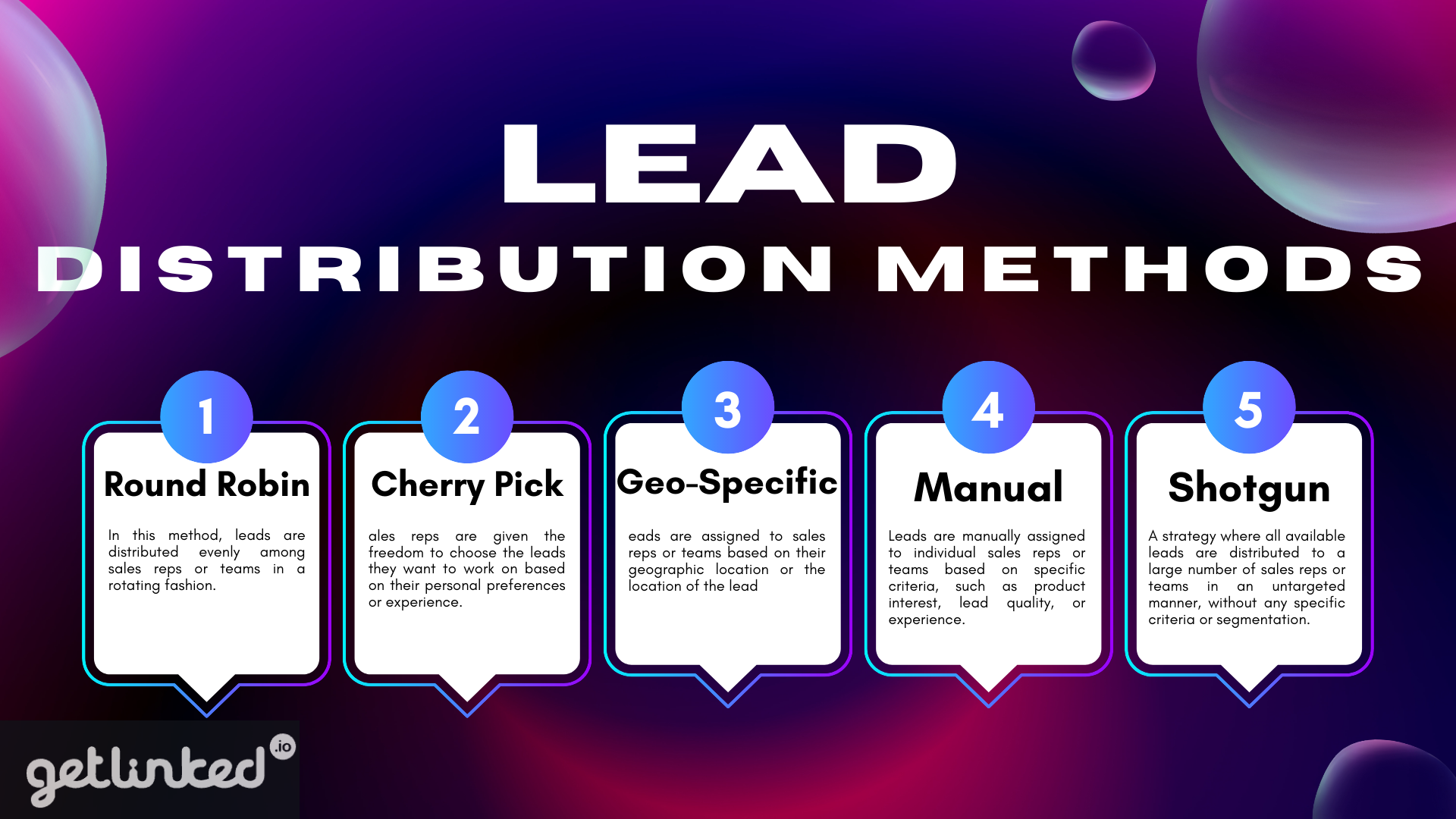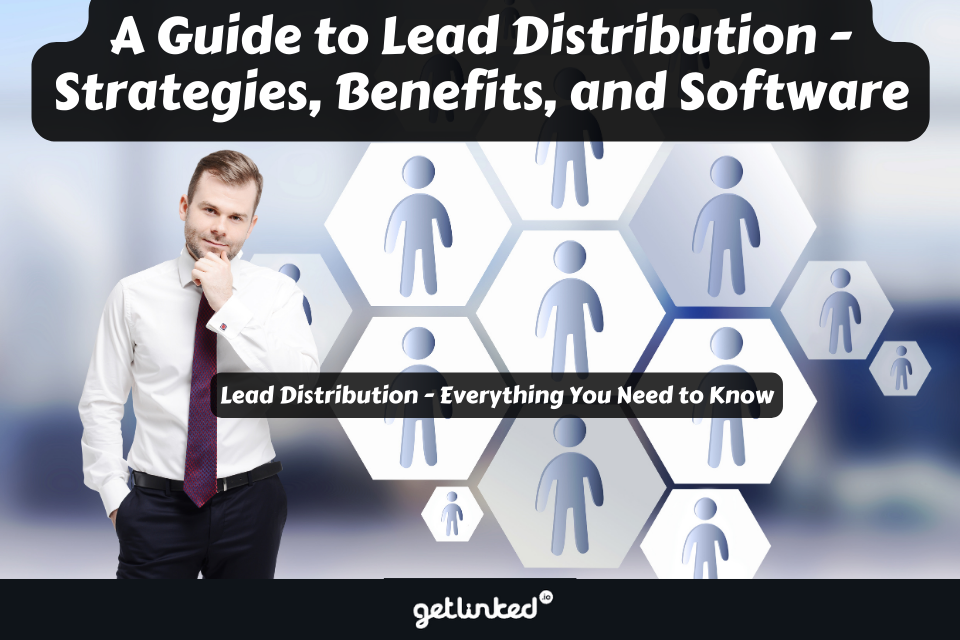Lead Distribution – Everything You Need to Know
Capturing and converting leads is essential for sustainable growth and success is challenging.
However, simply generating leads is not enough – businesses need an effective lead distribution strategy to ensure their sales team can follow up on leads quickly and efficiently. Lead distribution involves assigning leads to a sales rep or team based on predefined criteria, such as geographic location, product interest, and lead quality.
In this blog, we will explore what lead distribution is, how it works, the strategies and methods involved, why businesses use it, and best practices to follow for optimal results.
So whether you’re a small business owner or a sales manager in a large enterprise, this guide will provide valuable insights on how to optimize your lead distribution process and increase your chances of success. So, let’s dive in!
What is a Lead Distribution System?
Lead distribution is the process of assigning leads to sales reps or teams within a company for follow-up and conversion. It involves the distribution of sales leads to salespeople or teams based on predefined criteria, such as geographic location, product or service interest, and lead quality.
How Does Lead Distribution Work?
Lead distribution is a critical process for businesses that rely on lead generation to drive sales.
It involves capturing leads through various channels, such as a website, social media, events, and advertising campaigns, and then evaluating and qualifying them based on specific criteria.
The qualified leads are then assigned to sales reps or teams based on predefined criteria.
Finally, the sales reps follow up with the leads and work to convert them into customers. The effectiveness of the lead distribution process is monitored and optimized over time to improve conversion rates and ROI.
Here are the steps involved in lead distribution:
- Capture Leads – Leads are captured through various channels, such as a website, social media, events, and advertising campaigns. This is typically done using lead generation forms or landing pages that collect contact information from potential customers.
- Qualify Leads – Once leads are captured, they are evaluated and qualified based on criteria such as budget, buying intent, and fit with the company’s offerings. This ensures that only the most qualified leads are passed on to the sales team for follow-up.
- Assign Leads – Leads are assigned to sales reps or teams based on predefined criteria. This can be done manually or automatically using lead distribution software. The criteria for lead assignment can include factors such as lead quality, geographic location, and product interest.
- Follow-up and Conversion – Sales reps follow up with leads and work to convert them into customers. This typically involves a series of communications, such as phone calls, emails, or in-person meetings, to build relationships and address any questions or concerns the leads may have.
- Monitor and Optimize – The effectiveness of the lead distribution process is monitored and optimized over time to improve conversion rates and ROI. This involves tracking key metrics such as lead-to-opportunity conversion, lead quality, and sales revenue.
Lead Distribution Strategies and Routing Rules
Lead distribution, or lead routing, is the process of assigning leads to salespeople or teams for follow-up and conversion. As a whole, there are several strategies and methods involved in lead distribution, including:
Round-Robin Distribution
This lead distribution method involves distributing leads evenly among sales reps or teams in a rotating fashion. This ensures that each salesperson or team has an equal opportunity to work with new leads and can help to prevent leads from being neglected.
Territory-Based Distribution
With this method, leads are assigned to sales reps based on geographical territories. This can be useful for businesses that have a sales team covering specific regions or countries, as it ensures that leads in each area are handled by a local salesperson.
Account-Based Distribution
In this method, leads are assigned to sales reps based on specific accounts or target companies. This is often used in B2B sales, where salespeople may specialize in certain industries or target accounts.
Lead Scoring
This involves assigning leads a score based on their likelihood to convert, and then distributing them to the sales rep or team with the highest score. Lead scoring can be based on a variety of factors, such as demographics, behavior, and engagement.
Automated Distribution
With automated lead distribution, leads are automatically distributed using lead distribution software based on predefined criteria. This can include factors such as lead source, location, or product interest. Automation can help to reduce manual errors and speed up the lead distribution process.
Choosing the right lead distribution system depends on a variety of factors, such as the size of your sales team, the nature of your business, and your target market.

Why Businesses Use Lead Distribution
Lead distribution is an essential part of any sales operation as it helps businesses to improve their sales efficiency and effectiveness. By improving lead generation and distributing leads to the right sales reps or teams, companies can increase their conversion rates and revenue while minimizing the time and effort required to follow up with leads.
Effective lead distribution ensures that leads are assigned to sales reps with the right skills and experience, maximizing the chances of converting those leads into customers.
| Example
A lead with a specific product interest may be assigned to a sales rep with expertise in that product, improving the chances of a successful sale. By assigning leads to the right sales reps or teams, businesses can also reduce the time and effort required to follow up with leads, enabling sales reps to focus on their strengths and maximize their productivity. |
In addition to improving sales efficiency, lead distribution also helps businesses to increase revenue by improving their conversion rates. By using the distribution software to assign leads, businesses can reduce the likelihood of cherry picking and improve their chances of closing deals for generating revenue.
Overall, effective lead distribution is critical to the success of any sales operation.
Lead Distribution Best Practices
Implementing an effective lead distribution solution is critical for businesses looking to generate and convert leads. However, even with the best lead distribution software, success is not guaranteed. To optimize the process and improve conversion rates, it’s essential to follow best practices for lead distribution.
Here are some best practices to follow when implementing lead distribution:
- Define Lead Criteria – Clearly define the criteria for lead distribution based on factors such as lead quality, geographic location, and product interest.
- Use Automation – Consider using lead distribution software to automate the process and ensure consistency.
- Monitor and Optimize – Continuously monitor the effectiveness of the lead distribution process and optimize it over time to improve conversion rates and ROI.
- Provide training and Support – Provide training and support to sales reps to ensure they are equipped to effectively follow up with leads.
- Communicate with Prospects – Communicate with leads promptly and consistently to maintain engagement and build relationships.
By following these best practices, businesses can optimize their lead distribution process and increase their chances of success with qualified leads.
Factors to Consider When Choosing a Lead Distribution Platform
Lead distribution software helps businesses save time, reduce errors, and increase efficiency, however, with so many lead distribution systems available, it can be challenging to choose the right one. Some factors to consider when choosing a lead distribution software, to help you make an informed decision for your business include:
- Customization – Look for a lead distribution platform that allows you to customize lead distribution rules to fit your business needs. For example, you may want to assign leads to specific salespeople based on factors like geographic location or product expertise.
- Integration – Make sure the lead distribution software can integrate with your existing systems, such as your customer relationship management (CRM) system, marketing automation platform, or lead generation tools. This will help ensure a seamless transfer of leads between systems, avoiding data entry errors and saving time.
- Scalability – Consider whether the software can scale as your business grows. You may need to distribute more leads in the future, so it’s important to choose a solution that can handle a higher volume and number of types of leads.
- Reporting and Analytics – Look for a lead distribution system that provides detailed reporting and analytics. This will help you track the performance of your lead distribution strategy and make informed decisions about optimizing your process.
- Automation – Consider the level of automation the software provides. Ideally, the software should automate the lead distribution process as much as possible, reducing the need for manual intervention and increasing efficiency.
- Support – Finally, choose a lead distribution software provider that offers good customer support. You may encounter issues or have questions during the implementation process, so it’s important to have access to knowledgeable support staff who can assist you.
For more relevant information, visit our following related blogs:
|
Get the Best Lead Distribution Software With Getlinked
Effective lead distribution is critical to the success of any sales operation.
By implementing best practices such as defining lead criteria, using automation, monitoring and optimizing the process, providing training and support to sales reps, and communicating with prospects, businesses can optimize their lead distribution process and increase their chances of success.
When it comes to selecting a lead distribution software provider, it’s important to choose a reliable and trusted partner that can provide a powerful and customizable platform. That’s where we come in.
With our advanced lead distribution software, you can automate and optimize your lead distribution process, ensuring that leads are assigned to the right sales reps at the right time. Getlinked’s software also provides real-time reporting and analytics, allowing businesses to monitor and optimize their lead distribution process to maximize ROI.
In today’s competitive business environment, effective lead distribution can be the difference between success and failure. By partnering with Getlinked, businesses can leverage the power of advanced lead distribution software to streamline their sales operations and drive revenue growth.
For more information, contact us today.

